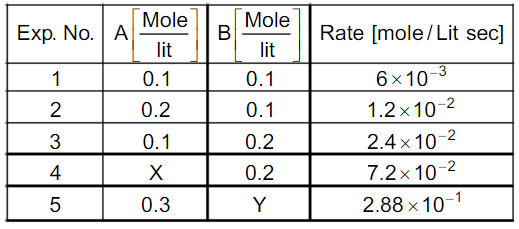The mechanism of the reaction: A+2B+C→D is
(step 1) (fast) equilibrium A+B⇔X
(step 2)(slow) X+C→Y
(step 3) (fast) Y+B→D
Which rate law is correct ?
A
v=k[C]
B
v–=k––[A][B]2[C]
C
v=k[A][B][C]
D
v=k[D]
Video Solution
Text Solution
The correct Answer is:C
r=K[X][C]
K'=[X][A][B]
r=K'[A][B][C]
|
Updated on:21/07/2023
Topper's Solved these Questions
- BOOK - A2ZCHAPTER - CHEMICAL KINETICSEXERCISE - Section B - Assertion Reasoning21videos
CHEMICAL KINETICS
- BOOK - A2ZCHAPTER - CHEMICAL KINETICSEXERCISE - AIPMT/NEET Questions43videos
CHEMICAL KINETICS
- BOOK - A2ZCHAPTER - CHEMICAL KINETICSEXERCISE - Arrhenius Equation, Effect Of Temprature And Effect Of Catalysts35videos
CHEMICAL KINETICS
- BOOK - A2ZCHAPTER - BIOMOLECULESEXERCISE - Section D - Chapter End Test30videos
BIOMOLECULES
- BOOK - A2ZCHAPTER - COORDINATION COMPOUNDSEXERCISE - Section D - Chapter End Test30videos
COORDINATION COMPOUNDS
Similar Questions
Knowledge Check
- Question 1 - Select One
For the reaction
2A+B→C

Find X & Y.A0.2,0.3B0.3,0.4C0.4,0.3D0.3,0.2 - Question 2 - Select One
Mechanism of a hypothetical reaction
X2+Y2→2XY is given below:
(i) X2→X+X (fast)
(ii) X+Y2⇔XY+Y (slow)
(iii) X+Y→XY (fast)
The overall order of the reaction will be :A2B0C1.5D1 - Question 3 - Select One
The reaction , X+2Y+Z→N occurs by the following mechanism
(i) X+Y⇔M (very rapid equilibrium)
(ii) M+Z→O (slow)
(iii) O+Y→N (very fast)
What is the rate law for this reactionARate =k[Z]BRate =k[X][Y]2[Z]CRate =k[N]DRate =k[X][Y][Z]
The rate law for the single step reaction 2A+B→X given by
View SolutionThe rate law for the single step reaction 2A+B→X given by
View SolutionThe mechanism of the reaction A+2B→C+D is:
Step I: A+Bk1⇐⇒k2I
Step II: B+Ik3−−→C+D
In the first step is a fast equilibruim , then the incorrect statement is :View SolutionA chemical reaction A+2B⇒AB2 follows in two steps
A+B⇒ AB(slow)
AB+B⇒AB2 (fast)
Then the order of the reaction isView SolutionThe reaction , X+2Y+Z→N occurs by the following mechanism:
(P) X+Y⇔M (rapid equilibrium)
(Q) M+Z→P (slow)
(R) O+Y+P→N (very fast)
What is the rate law for this reaction?View Solution

